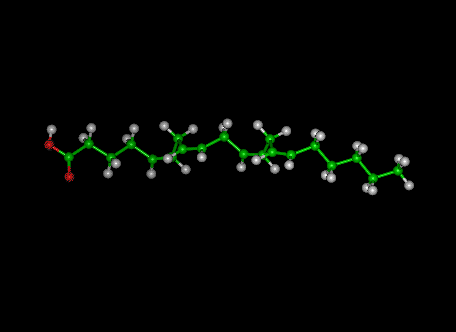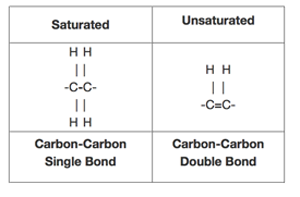Arachidonic Acid

The lipid shown here is Arachidonic Acid in a ball-and-stick configuration.
Arachidonic Acid 20:4

The structure of saturated and unsaturated chemical bonds looks like the diagram below.

Arachidonic acid is an omega-6 fatty acid with the chemical formula C20H32O2. In physiological literature, it is given the name 20:4(n-6). Its systematic chemical name is all-cis-5,8,11,14-eicosatetraenoic acid and its molecular weight is 304.5. Chemically, arachidonic acid is a carboxylic acid with a 20-carbon chain and four cis double bonds; the first double bond is located at the sixth carbon from the omega end. Some chemistry sources define 'arachidonic acid' to designate any of the eicosatetraenoic acids. However, almost all writings in biology, medicine and nutrition limit the term to all-cis 5,8,11,14-eicosatetraenoic acid.
Arachidonic acid is a polyunsaturated fatty acid that is present in the phospholipids (especially phosphatidylethanolamine, phosphatidylcholine and phosphatidylinositides) of membranes of the body's cells, and is abundant in the brain. Arachidonic acid is usually localized in the glycerol backbone sn-2 position. It is a precursor in the production of eicosanoids: the prostaglandins, thromboxanes, prostacyclin and the leukotrienes (through enzymes including cyclooxygenase, lipoxygenase and peroxidase). The production of these derivatives, and their action in the body, are collectively known as the arachidonic acid cascade; see Essential fatty acid interactions for details.
Arachidonic acid is freed from phospholipid molecule by the enzyme phospholipase A2. It is also involved in cellular signaling as a second messenger.
Arachidonic acid is one of the essential fatty acids required by most mammals. Some mammals lack the ability to—or have a very limited capacity to—convert linoleic acid into arachidonic acid, making it an essential part of their diet. Since little or no arachidonic acid is found in plants, such animals are obligatory carnivores; the cat is a common example.
Where is Arachidonic Acid Found?
Food sources of arachidonic acid (PFA 20:4), listed in descending order by percentages of their contribution to intake, based on data from the National Health and Nutrition Examination Survey 2005-2006| Rank | Food item | Contribution to intake (%) | Cumulative contribution (%) |
|---|---|---|---|
| 1 | Chicken and chicken mixed dishes | 26.9 | 26.9 |
| 2 | Eggs and egg mixed dishes | 17.8 | 44.7 |
| 3 | Beef and beef mixed dishes | 7.3 | 52.0 |
| 4 | Sausage, franks, bacon, and ribs | 6.7 | 58.7 |
| 5 | Other fish and fish mixed dishes | 5.8 | 64.5 |
| 6 | Burgers | 4.6 | 69.1 |
| 7 | Cold cuts | 3.3 | 72.4 |
| 8 | Pork and pork mixed dishes | 3.1 | 75.5 |
| 9 | Mexican mixed dishes | 3.1 | 78.7 |
| 10 | Pizza | 2.8 | 81.5 |
| 11 | Turkey and turkey mixed dishes | 2.7 | 84.2 |
| 12 | Pasta and pasta dishes | 2.3 | 86.5 |
| 13 | Grain-based desserts | 2.0 | 88.5 |
Specific foods contributing at least 1% of eicosatetraenoic acid in descending order: shrimp and shrimp mixed dishes, soups, regular cheese.
Source: National Cancer Institute
What does arachidonic acid do in the body?
Arachidonic acid is an omega 6 fatty acid which can increase inflammation in some situations.
Most of the released AA (from cells) is metabolized into a variety of compounds through a number of different pathways. Some of these include
1) Production of prostaglandins metabolized by COX-1 and COX-2 (cyclooxygenase) enzymes.
2) Conversion of arachidonic acid into leukotrienes, lipoxins, and hydroxyeicosatetraenoic acids (HETE) through the action of the enzyme lipoxygenase.
3)The oxidation of arachidonic acid by P450 enzymes into eicosatrienoic acid products
Arachidonic acid is a most needed nutritional supplement for infants
"...ARA and docosahexaenoic acid (DHA, 22:6 ω3) are important components of human milk but are lacking in cow milk and most commercial infant formula in developing countries. Due to its importance in development especially of the central nervous system and retina, the Food and Agricultural Organization (FAO)/World Health Organization (WHO) recommended that infant formula, unless specifically added, should be supplemented with ARA. Decreased postnatal ARA and DHA blood levels in premature infants were found to be associated with neonatal morbidities, while adding DHA and ARA to preterm-infant formulas led to improved visual acuity, visual attention and cognitive development..." see: Arachidonic acid: Physiological roles and potential health benefits – A review and references included.
Fats in Cooking and Health
- What are the differrent types of fatty acids?
- What are Trans Fats?
- What is the difference between LDL and HDL?
- What are the different types of omega 3 fatty acid?
- What are omega-6 fatty acids?
- The importance of the ratio of omega-6/omega-3 essential fatty acids
- What is the difference between saturated and unsaturated fats?
- What causes oils to go rancid?
- What are essential fatty acids?
- Duck Fat as an alternative to butter
- How to render duck fat
- Did butter get a bad rap?
Types of Fatty Acids
Saturated